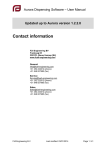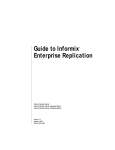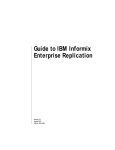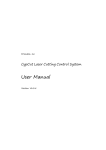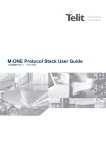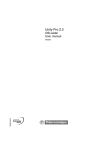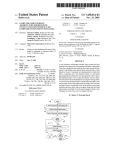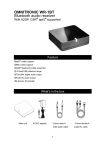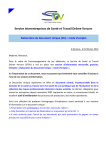Download FB12 Single Tube Luminometer
Transcript
FB12 Single Tube Luminometer User’s Manual FB12-e-07/04 © Berthold Detection Systems GmbH, 2004 FB12 Luminometer Contents Contents Safety Instructions.......................................................................................1 1. Getting Started.....................................................................................3 2. Structure of Microprocessor Software ..............................................5 3. 3.1 3.2 3.3 Measurement in Stand-alone Mode ...................................................7 Overview................................................................................................7 Raw Data Measurement........................................................................9 Check Mode ........................................................................................10 4. 4.1 4.2 4.3 Working with the FB12 PC Software................................................11 PC Software Installation ......................................................................11 First Program Start ..............................................................................12 Basic Software Structure .....................................................................13 4.3.1 Protocol Manager......................................................................14 4.3.2 Measurement Menu ..................................................................15 4.3.3 Working with the Software ........................................................16 4.4 FB12 Luminometer Setup ...................................................................17 4.5 Comparison of Software Protocols ......................................................19 5. Quick Measurement ..........................................................................20 5.1 Protocol ...............................................................................................20 5.2 Measurements.....................................................................................20 6. Single Assay ......................................................................................21 6.1 Protocol ...............................................................................................21 6.2 Measurements.....................................................................................23 7. Dual Assay .........................................................................................24 7.1 Protocol ...............................................................................................24 7.2 Measurements.....................................................................................26 8. Single Kinetics...................................................................................27 8.1 Protocol ...............................................................................................27 8.2 Measurements.....................................................................................29 9. Multiple Kinetics ................................................................................30 9.1 Protocol ...............................................................................................30 9.2 Measurements.....................................................................................31 10. Cut-off Assay .....................................................................................33 10.1 Protocol ...............................................................................................33 10.2 Measurements.....................................................................................35 Contents FB12 Luminometer 11. 11.1 11.2 11.3 11.4 11.5 11.6 External Printer with Additional Options ........................................ 36 Physical Installation of the Printer....................................................... 36 Printer Setup ....................................................................................... 37 Cut-off Protocol................................................................................... 37 Cut-off Measurement .......................................................................... 39 Extended Raw Data Protocol.............................................................. 40 Raw Data Measurement ..................................................................... 41 12. Maintenance ...................................................................................... 42 13. Technical Data................................................................................... 43 14. Preparing FB12 for Transport .......................................................... 45 15. Index .................................................................................................. 47 16. Decontamination Form ..................................................................... 49 Typographical Conventions FB12 Luminometer Messages on the LC display are printed in boldface type, e.g. menu MEASURE, SCROLL or MAIN. The <ENTER> function key is printed in boldface inside pointed brackets. PC software Menu and option titles of the PC software are printed in boldface inside square brackets ([ ]), e.g., [File], [Options]. PC software buttons are printed in boldface inside pointed brackets (<>), e.g., <OK>, <Start Quick Measurement>, <F1>, <enter>, <Alt>. FB12 Luminometer Safety Instructions Safety Instructions ! The FB12 luminometer was manufactured in accordance with safety requirements for electronic and medical luminometers. It is the operator's responsibility to adhere to regulations on the installation and/or operation of sample measuring systems that are required by law. The manufacturer guarantees safe operation of the equipment, both electrically and mechanically, if user follows the instructions set forth in this manual. The user must ensure that the instruments are set up and installed in such a way that their function is not impaired. The instruments have been tested by the manufacturer and are supplied in a condition that allows safe and reliable operation. This User’s Manual includes information and warnings that have to be observed by the user to ensure safe operation of the instruments. Please adhere to the following safety instructions before taking the instrument into service and during operation of the system: 1. Only trained personnel may operate the instrument. It is strongly recommended that all users read this manual prior to use. 2. The instrument may only be used for the designated application. A single sample luminometer is employed for detection of chemi- and bioluminescence in different sample tube formats. 3. Berthold Detection Systems assumes no liability for any damages, including those to third parties, caused by improper use or handling of the device. 4. The system is designed according to the IEC 1010-1 or EN 610 10-1 regulations for electrical measuring systems. 5. Only qualified personnel may carry out Service and repair work . Reassemble it completely before use. 6. The user may only perform the maintenance work described in this manual. 1 Safety Instructions FB12 Luminometer 7. Use only parts described in this manual for servicing. 8. The instruments are live and improper handling may cause damage. 9. If you realize that the instrument has become unsafe to use, switch it off and disconnect it from the power supply. 10. All instruments supplied and all additional devices must be grounded. Use three-prong, grounded plugs. ! 11. Before opening the locking screw or the instrument head on the top side of the instrument, disconnect power and then open the sample drawer to protect the photomultiplier against direct incident light. Otherwise, the photomultiplier may get damaged! Do not keep the sample drawer open for a long period of time. 12. If liquid gets inside the instrument, pull the power cord. Clean the unit or have it cleaned by an authorized service center . The tests and maintenance work recommended by the manufacturer should be performed to make sure that the operator remains safe and that the instrument continues to function correctly. Authorized service engineers must perform any service and maintenance work not described in the operating manual. Return shipment ! 2 If the instrument has to be returned to Berthold Detection Systems for servicing or inspection, we recommend that you use the original cardboard box. Please remove the reflector (sample holder) in order to avoid damage to the sample chamber (see chapter 14). FB12 Luminometer 1. Getting Started 1. Getting Started Description The FB12 luminometer is a highly sensitive and compact single sample luminometer, designed specifically for the detection of chemiluminescence and bioluminescence in different kinds of applications. It can be employed for all glow type measurements. The sample chamber accommodates various sample formats. FB12 may be operated as a standalone instrument using special Windows software.. Optionally, an external printer can be connected to the FB12. In this case, additional cut-off measurements can be run on the standalone instrument and the results can be output to printer (see chapter 11). Luminometer installation The instrument should be set up in a dry, dust-free environment and protected from direct sunlight and significant temperature fluctuations! Carefully unpack the FB12 Luminometer and put it on your desktop. Plug the connector module that fits into your wall outlet onto the power supply unit. Plug the power supply unit into a wall outlet and the pin connector of the power supply unit into the socket on the instrument rear panel. Turn the instrument on at the mains switch. The display will show: „Please wait“ while the instrument is performing a selftest. Then the main menu appears. Open the sample drawer and insert the sample holder (reflector). Different sample formats may be used: Culture dishes with up to 35 mm diameter Scintillation bottles containing up to 20 ml Reaction bottles with up to 12 mm diameter and up to 75 mm length (see chapter 13). 3 1. Getting Started Figure 1: FB12 Luminomete r (rear view) FB12 Luminometer ON/OFF switch Serial port Socket Configuration Set up the instrument parameters according to your needs as follows (confirm entries with <Enter>, push <Next> to continue with next display): FB12 LUMINOMETER MEASURE MEAS.SET. NEXT PC-OPER SYSTEM MAIN SYSTEM CONFIG CHECK NEXT USE RS232 FOR SCROLL MAIN PC/PRINTER: NEXT Select PC if the FB12 is used as standalone instrument for raw data measurements or if the luminometer is connected to a PC. If you are using the FB12 as standalone instrument to run cutoff measurements or you want to print out raw data, then connect an external printer and select PRINTER (see chapter 11). Then select the desired language and enter Date and Time, Baudrate (9600) and the RLU factor = 1. 4 FB12 Luminometer 2. 2. Structure of Microprocessor Software Structure of Microprocessor Software Operating elements on the front panel Figure 2: Operating elements on front panel FB12 LUMINOMETER V3.0 MEASURE MEAS.SET. NEXT ENTER FB12 Luminometer Main menu Softkey Function key <enter> Meaning and operation of individual functions MEASURE Measurement in stand-alone mode after input of measurement parameters and configuration. MEAS.SET. Define the measurement parameters for stand-alone operation. If the interface is set to PRINTER, you may choose parameter entry either for a raw data or for a cut-off measurement (see chapter 11). PC-OPER Switchover to PC-OPERATION. This function is not available if the interface has been set to PRINTER. SYSTEM CONFIG: Define the system parameters. CHECK: Here a continuous measurement is performed (see chapter 3.3). Accept Confirm each entry or new setting with <ENTER>. If you want to keep a setting, you may proceed directly with NEXT or MAIN. Input CURSOR Move the cursor left. SCROLL The highlighted digit or letter is incremented by 1 (cyclical order: 0, 1... 9, 0, 1... and A, B ...Z, A ...). 5 Open/close the door 30 RLU/s END SYSTEM ARE YOU SURE? YES NO PC-OPERATION 30 RLU/s DOOR CLOSED END Close the door PC-OPERATION DOOR OPEN PC-OPER Menu Structure of the Instrument Software NEXT Serial port set to printer PROTOCOL: RD / CUT-OFF SCROLL MAIN NEXT CUT-OFF OPERATOR: ....................... SCROLL CURSOR NEXT RD OPERATOR: ..................... SCROLL CURSOR NEXT 1 NEXT MEASURING TIME: 10.0 s SCROLL CURSOR MAIN DELAY TIME: 2.0 s SCROLL CURSOR NEXT SAMPLE REPL: SCROLL MAIN NEG.STAND.REPL : 2 SCROLL MAIN NEXT CUT-OFF-FACTOR: X.XXX SCROLL CURSOR NEXT TESTNAME: ...................... SCROLL CURSOR NEXT MEASURING TIME: 10.0 s SCROLL CURSOR MAIN DELAY TIME: 2.0 s SCROLL CURSOR NEXT TESTNAME: ........................ SCROLL CURSOR NEXT Serial port set to PC FB12 LUMINOMETER V3.0 MEASURE MEAS.SET. 2. Structure of Microprocessor Software CUT-OFF MEASUREMENT Serial port set to printer and Cut-off protocol selected RD Open/close door MEASURE 30 RLU/s D= 2.0s T= 10.0s MAIN READY 30 RLU/s D= 2.0s T= 10.0s MAIN MEASURE 30 RLU/s NEGREPL 1 D= 2.0s T= 10.0s MEASURE 30 RLU/s D= 0.0s T= 10.0s MAIN MAIN MEASURE 4500 RLU/s NEGREPL1 D= 0.0s T= 6,5s MEASURE 4520 RLU/s D= 0.0s T= 6.5s MAIN INSERT NEGREPL1 CLOSE DOOR DONE 4500 RLU/s REMOVE NEGREPL1 MAIN DONE 4500 RLU/s REMOVE SAMPLE MAIN Open door MAIN INSERT NEGREPL2 CLOSE DOOR Close door MEASURE 30 RLU/s NEGREPL2 D= 2,0s T=10,0 s MEASURE 4500 RLU/s NEGREPL2 D= 0,0s T=6,5 s DONE 4500 RLU/s REMOVE NEGREPL2 MAIN Sample measurement 30 RLU/s T=10.0 s INSERT SAMPLE 1 REPL1 CLOSE DOOR MAIN CLOSE DOOR MEASURE S1R1 D=2.0s DONE 4500 RLU/s REMOVE S1R1 MAIN 6 MAIN SYSTEM CONFIG CHECK MAIN NEXT NEXT USE RS232 FOR: PC/PRINTER SCROLL LANGUAGE: ENGLISH SCROLL MAIN NEXT 9600 NEXT DATE: 01.08.2003 09:37 SCROLL CURSOR NEXT BAUDRATE: SCROLL MAIN RLU-FAKTOR: 1.000 SCROLL CURSOR MAIN MAIN FB12 Luminometer PROTECTED ENTER PASSWORD: XXXX SCROLL CURSOR NEXT 22 RLU/s MAIN MEAS.TIME: 10 .0 s SCROLL CURSOR NEXT MEASURE T=10.s FB12 Luminometer 3. Measurement in Stand-alone Mode 3. Measurement in Stand-alone Mode 3.1 ! Overview The luminometer should be switched on at least 30 minutes before starting a measurement. Units Luminescence is measured in „Relative Light Units“ (RLU). The RLU/s displayed by the FB12 luminometer are equal to the counts/s picked up by the detector, with the default RLU factor set to 1. RLU/s = cps ßRLU factor The factory-set factor (=1) should be changed only when comparing results measured with different luminometers. The entered factor multiplies all measured results; it is changed on the main menu under SYSTEM. Overload If one or several measured values in the measurement interval exceed the measuring range of the luminometer, OVERLOAD appears on the display. To obtain a meaningful result, the sample has to be diluted and measured again. DONE REMOVE SAMPLE OVERLOAD RLU/s MAIN Definition of measurement and delay time Figure 3: Illustration of delay and measurement times delay time measurement time Close sample drawer Time axis (seconds) All delay times start with the closing of the sample drawer. The minimum delay time is 1 s. 7 3. Measurement in Stand-alone Mode FB12 Luminometer Discarding and repeating a measurement Opening the sample drawer will terminate a measurement. In the raw data mode the display shows: MEAS. ABORTED! PRESS ENTER! Close the sample drawer and push <ENTER> to start the next measurement. In case of a cut-off measurement (only possible if the interface has been set to PRINTER), the following display appears: MEAS. ABORTED! REPEAT REPEAT DISCARD Repeat measurement of replicate sample. DISCARD Measure next sample. The measured values are calculated depending on this selection. Data output on display Only raw data in RLU/s are displayed. 8 FB12 Luminometer 3. Measurement in Stand-alone Mode 3.2 Raw Data Measurement In the raw data mode, samples are measured and numbered consecutively. Creating a protocol1) FB12 LUMINOMETER MEASURE MEAS.SET DELAY TIME: SCROLL MEASURING TIME: SCROLL NEXT CURSOR 2.0 s NEXT CURSOR 10.0 s MAIN Define delay time and measurement time. Press MAIN to return to the main menu. Raw Data Measurement The display shows the main menu: FB12 LUMINOMETER MEASURE MEAS.SET READY D= 2.0s Insert sample tube measurement starts. MEASURE D= 2.0s T= 10.0s and close NEXT 30 RLU/s MAIN sample 4500 T= 10.0s drawer. The RLU/s MAIN At the end of the measurement time the following display appears: DONE REMOVE SAMPLE 4500 RLU/s MAIN 1) If the interface has been set to PRINTER, you can here choose between raw data and cut-off (see chapter 11). 9 3. Measurement in Stand-alone Mode 3.3 FB12 Luminometer Check Mode The check function enables the user to check the photomultiplier if no measurement is running. The measured RLU values are displayed continuously regardless of whether the sample drawer is open or closed. Push MAIN to terminate the measurement. PC-OPER SYSTEM MAIN Push the SYSTEM button to open the PARAMETER menu. SYSTEM CONFIG CHECK NEXT Push the CHECK button. The selected measurement time is used as integration time. MEAS. TIME SCROLL CURSOR 10.0s NEXT Change the measurement time with SCROLL and confirm with <ENTER>. Push NEXT to start the measurement. MEASURE T = 10.0s Push MAIN to return to the main menu. 10 22 RLU/s MAIN FB12 Luminometer 4. Working with the FB12 PC Software 4. Working with the FB12 PC Software 4.1 PC Software Installation Close all Windows applications. Insert software CD in the CD drive. CD navigator is supposed to automatically start your internet browser. Select “Software” in the navigator bar, then “FB12/Sirius Software Installation” on the respective site. Double-click the Setup.exe file displayed in your Windows Explorer to start the setup program. Alternatively, if the CD navigator does not automatically pop up, chose the [Start] menu in Windows. The [Run] dialog box appears. In the [Open] text box, type x:\FB12\Software\Setup.exe (x stands for your CD drive). This will start the setup program too. Click <Next>: [Select Program Manager Group]. Click <Next> (display of [Start Installation]). Click <Next> to start the installation. If the prompt [Place installation disk2] is displayed, insert the installation disk 2 with the file FB12Setup.WO2 in drive A:/. Upon completion of the installation process, click <Finish>. The software includes a 30 days trial option for non-purchased software components. Important information for Windows NT/2000 users ! Please make sure to install and run the software in the administrator mode. If this is not possible you should obtain the required user rights from the administrator in order to be able to work with the software. 11 4. Working with the FB12 PC Software FB12 Luminometer Installation of additional protocol types Proceed as described above. Select the protocol types you want in the [Software Components] dialog box. Then complete the installation. 4.2 First Program Start Double-click on the FB12 software ICON. Click on the <Options> button. Select the serial port used (COM1 or COM2) in the [Serial Port] box. Set the baud rate to [9600]. In the [Default Data storage directory] box, enter the directory where you wish to save the measurement data. If you want to hear a signal at the end of a measurement, select the item [Beep when measurement is completed]. Click <OK> to save the entries. The program changes to the Protocol Manager. Software Registration Enter the registration passwords (one for each protocol type) in the [Registration Form] dialog box. 12 FB12 Luminometer 4. Working with the FB12 PC Software 4.3 Basic Software Structure Protocol Manager Figure 4: Structure of FB12 PC program Opening a data file Create a protocol Save Measurement menu Graphics display EXCEL EXCEL transfer options 13 4. Working with the FB12 PC Software FB12 Luminometer 4.3.1 Protocol Manager [Protocol types] Shows the protocol types which can be used as templates for creating protocols. [Runable protocols] Shows a list of created protocols. Protocols are edited using the buttons in this box: <Run> Shows the measurement menu and you can start a measurement with the selected protocol. <Edit> Edit the parameters in the selected protocol. <Delete> Delete the selected protocol. Quick Measurement is not a protocol type, but a measurement protocol; parameters may be changed, but may not be stored in separate protocols. <Retrieve> Shows the stored measurement data; double-click to open the desired data file (*.MDS). 14 FB12 Luminometer 4. Working with the FB12 PC Software 4.3.2 Measurement Menu Select the desired protocol and click <Run>. The measurement menu is displayed. Before starting a run On the luminometer: Select NEXT and then PC-OPER (see chapter 4.4). Measurement start By opening / closing the sample drawer or pressing the green button or the spacebar. Meas. completed As soon as the measurement time is over. Measurement stop By opening the sample drawer or pressing the red button. Single values Measured results are transferred from the luminometer to the PC every 0.2 seconds. To view single values, place the cursor over a measured result. Result fields To change the size of a result field, move cursor to the right-hand margin of the header. As soon as the cursor shape changes to a double-arrow, click the left mouse button and drag the cursor, with the mouse button held down, left or right. EXCEL Transfer Click the button depicted to the left to manually import data into a new or predefined Excel worksheet. The transfer may also be automated in the protocol. 15 4. Working with the FB12 PC Software FB12 Luminometer 4.3.3 Working with the Software Tool buttons on the measurement menu simplify program handling. Apart from a few exceptions you need not select any pull-down menus. Tool buttons and their meaning: Button Meaning Pull-down menu -> Option Save measurement data [File] -> [Save (as)] Import measurement data into Excel [Edit] ->[Send to Excel] Print [File] -> [Print] Start measurement [Measure] -> [Start Measurement] Stop measurement [Measure] -> [Stop Measurement] Delete last measurement [Measure] -> Measurement] Display results in spreadsheet [Measure] -> [Kinetics] Display results in a graph [Measure] -> [Kinetics] Tile window horizontally [Window] -> [Tile Horizontal] Tile window vertically [Window] -> [Tile Vertical] Create new data file in measurement menu Copy selected data to clipboard 16 [Delete Last FB12 Luminometer 4. Working with the FB12 PC Software 4.4 FB12 Luminometer Setup Connect the FB12 luminometer with the cable supplied to a serial COM port on your PC. Select NEXT and PC-OPER on the main menu to set the FB12 luminometer to PC operation. FB12 Luminometer Measure MEAS.SET NEXT FB12 Luminometer PC Oper MAIN SYSTEM PC-OPERATION DOOR OPEN 30 RLU/s END The measuring instrument is now in the PC operation mode. The measured values are displayed continuously in the top row. The bottom row shows the status of the sample drawer. Push END to return to the standalone mode. Note! The function PC operation is not available if the serial interface has been set to PRINTER. To configure the interface for PC operation, set the RS232 interface configuration on the SYSTEM menu to PC communication. SYSTEM SYSTEM CONFIG RS232 FUER SCROLL CHECK NEXT NEXT PC/PRINTER MAIN NEXT 17 4. Working with the FB12 PC Software FB12 Luminometer Push SCROLL and change the instrument from PRINTER configuration to PC configuration. Push <ENTER> to confirm your entry. Push MAIN to return to the main menu. On the main menu, select NEXT and then PC-OPER which is now available. 18 FB12 Luminometer 4. Working with the FB12 PC Software 4.5 Comparison of Software Protocols To help you get a quick overview of the different protocol types, we have summarized their functions in the table below: Quick Measur. Function st 1 sample = BG no Single Assay Single Kinetics Multiple Kinetics Dual Assay Cut-OffAssay Measurement of Continuous several samples measurement of one sample with replicates Several samples, discontinuous measurement Measurement of Classification of sample series A samples and B yes no no yes Yes BG may be defined BG may be defined Replicates no flexible yes yes same number for A and B yes: for samples, neg. and pos. controls Number of samples any flexible 1 sample measured with any data points any, with any data points same number for A and B yes: for samples, neg. and pos. controls Calculations none >1 replicate: >1 replicate: >1 replicate: >1 replicate: >1 replicate: average value average value average value average value average value %stdv/av %stdv/av %stdv/av %stdv/av %stdv/av repl. 1, repl. 2 log/normal scaling, repl. 1, repl. 2 log/normal scaling, smoothing, smoothing, peak half-life time during increase and decay peak half-life time during increase and decay complete graph of all replicates complete graph of all replicates always for last sample always for last sample measurement start only at closing of sample drawer predefined sample names predefined sample names different calculation formulas for A and B different cut-off calculations and classifications Kinetics graph none always for last sample Miscellaneous Meas. predefined sequence sample names BG = Background 19 5. Quick Measurement FB12 Luminometer 5. Quick Measurement This protocol type measures the raw data of consecutively numbered samples. 5.1 Protocol In the Protocol Manager, select the [Quick Measurement] protocol and click <Edit>. The [Quick Measurement Parameters] dialog box appears. Set Delay time for the measurement and Measurement time by clicking on the respective arrow buttons. Click <Save> to save the measurement parameters. The program returns to the Protocol Manager. 5.2 Measurements In the Protocol Manager, select the [Quick Measurement] protocol and click <Run>. The measurement menu appears showing the parameters Measurement time and Delay time defined for the measurement. Open sample drawer and insert sample tube. Close sample drawer. The measurement process starts as soon as the preset delay time is over. The result is displayed at the end of the measurement. Proceed in the same manner to measure the next sample. 20 FB12 Luminometer 6. Single Assay 6. Single Assay This protocol type allows you to run background measurements and to measure replicates of samples. 6.1 Protocol Select Single Assay and push <Create>. Figure 6-1: Dialog box [Single Assay Parameters] Page 1 [Delay time] Delay before measurement; can be set only if a measurement is started by closing the sample drawer. [Measurement time] Measurement time for each sample measurement. [Start Meas. by] Select how to start the measurement on the measurement menu: [Start button] By clicking the Start button or pressing the spacebar. No delay time can be defined here! 21 6. Single Assay FB12 Luminometer [Door close] By closing the sample drawer of the luminometer. [Number of replicates] [Number of samples] [First sample is background] Measurements of the first sample replicate are considered background measurements. <Advanced Options> Opens page 2 of the Single Assay Parameters dialog box. Figure 6-2: Dialog box [Single Assay Parameters] Page 2 [Grid Options] You may select a flexible table set-up, so that the number of replicates and/or samples may be changed during measurement at the push of a button. [Measurement orders] Order of measurement Sample Rep1 1 2 3 22 [Across] Measurements are carried out by rows: first, all replicates of Rep2 the first sample, then all those of the second sample, etc. FB12 Luminometer Sample Rep1 1 2 3 6. Single Assay Rep2 [Down] Measurements are done by columns, e.g. first the first replicate of all samples, then the second replicate of all samples, etc. 6.2 Measurements Preparation At luminometer: Select NEXT and then PC-OPER. In the PC software : Select a protocol (type Single Assay), click <Run> and the program will go to the measurement menu. Parameter Display of the run parameters. If you have defined the number of replicates as variable, you may change this by clicking on the respective button. A background value can also be set manually if no background measurement is carried out. The value entered here is subtracted from the raw data of each sample. Measurement start By opening / closing the sample drawer or by clicking on the Start button. Results Graph The measurement values will be displayed in a table depending on the definition in the protocol with the following columns (one row for each sample): [Sample] Sample name. [Rep...] One column has been reserved for each replicate. If the number of replicates was defined as variable in the protocol, you may increase the number of columns by clicking the appropriate button (+). [Average] This column contains the average values, calculated from the replicate results of that row. [%SD/Avg] Standard deviation in percent, divided by average value. [Net] Average value minus background value. [%SD/Net] Standard deviation in percent, divided by net average value. The measurement data trend of each single measurement with data points can be displayed in a graph, either online or at the end of the measurement, by clicking the graph button. 23 7. Dual Assay FB12 Luminometer 7. Dual Assay In the measurement mode Dual Assay two sample sequences A and B are measured. Subsequently, a mathematical correlation is established between both measurement sequences. Typical application: Dual reporter gene assays. 7.1 Protocol Select Dual Assay and press <Create>. Figure 7-1: Dialog box [Dual Assay Parameters] Page 1 [Series A measurement and delay time] [Delay time] Delay for sequence A prior to each measurement; can be set only if a measurement is started by closing the sample drawer. [Measurement time] for each sample measurement of series A. [Series B measurement and delay time] Enter parameters for series B in the same manner as for series A. 24 FB12 Luminometer 7. Dual Assay [Start Meas. by] Select how to start the measurement: [Start button] By clicking on the Start button or by pressing the spacebar. No delay time can be defined here! [Door close] By closing the sample drawer. [Number of replicates and samples] [Number of replicates] [Number of samples] [First sample is background] Measurements of the first sample replicate are considered background measurements. [Measurement options] [Transform] Select the calculation formula. [Measurement order] Selection of order: Either one sample of sequence B after each one of sequence A, or all samples of sequence A in a row and then all those of sequence B. 25 7. Dual Assay FB12 Luminometer 7.2 Measurements Preparation At luminometer: Select NEXT and then PC-OPER. In the PC software: Select a protocol (type Dual Assay), click <Run> and the program will go to the measurement menu. Parameter Display of measurement parameters series A and series B. The measured background values are displayed in the [Background A] and [Background B] text boxes, if the first sample of each sequence was defined as background in the protocol. A background value can be entered manually. The value displayed here will be subtracted from the raw data of each sample. Measurement start By opening / closing the sample drawer or by clicking the Start button. Results Display of measured values: [Sample] Sample name. [Net A] Net rate of series A = average value of the replicates of the first sample of sequence A, minus background. [Net B] Net rate of series B [A ...B] Calculation of the two net rates according to the formula defined in the protocol [%SD/Avg] Standard deviation in percent/average value. [Rep ...A] Measurement value for replicates of series A. [Average A] Average value from replicate results of series A of the respective row. [%SD/Avg] Standard deviation in percent/average value. [Net] Average value minus background (series A). [%SD/Net] Standard deviation in percent/average value. The following columns contain the measured values for series B. 26 FB12 Luminometer 8. Single Kinetics 8. Single Kinetics The measurement type Single Kinetics is used to measure the trend of the light emission over a specific period of time. 8.1 Protocol Select Single Kinetics and push <Create>. Figure 8-1: Dialog box [Single Kinetics Parameters] Page 1 [Time settings] The following 5 parameters of this group box are mutually conditional (with the exception of delay time): [Delay time] Delay before each measurement; can be set only if a measurement is started by closing the sample drawer. [Total duration] Total sample measurement time, including the following times: [Sampling time] Measurement time per data point. 27 8. Single Kinetics FB12 Luminometer [No. of Data points] Number of data points multiplied by the interval time shows the total duration of the measurement. [Interval time] The interval time may be longer than the individual measurement time of the data point. [Start Meas. by] Select how measurement is to be started on the measurement menu. [Start button] By clicking the Start button or pressing the spacebar. No delay time can be defined here! [Door close] By closing the sample drawer. Measurements with injectors can only be started in this manner. [Number of replicates] <Advanced Options> Click this button to open page 2 of the Single Kinetics Parameters dialog box. [Use luminometer as time basis] Select the luminometer as time basis. 28 FB12 Luminometer 8. Single Kinetics 8.2 Measurements Preparation At luminometer: Select NEXT and then PC-OPER. In the PC software: Select a protocol (type Single Kinetics), click <Run> and the program will go to the measurement menu. Parameter Display of measurement parameters. You may type a background value into the [Background RLU/s] box. The value entered here is subtracted from the raw data of each sample. Measurement start By opening/closing the sample drawer or by clicking the Start button. Results Graph The measurement values will be displayed in a table depending on the definition in the protocol with the following columns (one row for each sample): [Time] Length of time the light emission is measured. [Rep...] Measurement values for individual replicates. [Average] Average value of replicates. [%stdv/Av] Standard deviation in percent, divided by average value. [Net] Net value (average value minus BG value) [%SD/Net] Standard deviation in percent, divided by net average value. The measurement data trend of each single measurement can be displayed in a graph, either online or at the end of the measurement, by clicking the graph button. Further options for processing the graph become visible when you enlarge the graph window. [Group] Select which replicate curve(s) is to be displayed. [Smoothing] Smoothes all displayed curves. [Log scale] Logarithmic scaling. [RLU-range] Select if scaling is to be applied automatically or manually. 29 9. Multiple Kinetics FB12 Luminometer 9. Multiple Kinetics In the Multiple Kinetics mode, the trend of several samples is measured in parallel over a longer period of time. 9.1 Protocol Select Multiple Kinetics and push <Create>. Figure 9-1: Dialog box [Multiple Kinetics Parameters] Page 1 [Time settings] The following 5 parameters of this group box are mutually conditional (with the exception of delay time): [Delay time] Delay before every measurement. [Total duration] Total sample measurement time, including the following times: [Sampling time] Measurement time per data point. 30 FB12 Luminometer 9. Multiple Kinetics [No. of Data points] Number of data points multiplied by the interval time shows the total duration of the measurement. [Interval time] The interval time may be longer than the respective measurement time of the data point. [Number of replicates / samples] The number of replicates or samples. Please note: A measurement can only be started by closing the sample drawer. 9.2 Measurements Preparation At luminometer: Select NEXT and then PC-OPER. In the PC software: Select a protocol (type Multiple Kinetics), click <Run> and the program will go to the measurement menu. Parameter Display of measurement parameters. You may type a background value into the [Background RLU/s] box. The value entered here is subtracted from the raw data of each sample. Measurement start By opening/closing the sample drawer or by clicking the Start button. Results Measured values are displayed in a table: [Time] Length of time, over which the light emission is measured. The number of data points in [time] is calculated by dividing the total measurement duration by the interval time. [S1 Rep1] Measurement value of the first replicate of the first sample. [S1 Rep2] Measurement value of the second replicate of the first sample. [Average] Average value of replicates of the first sample. [%SD/Avg] Standard deviation in percent, divided by average value. [Net] Net value (average value minus BG value). 31 9. Multiple Kinetics Graph 32 FB12 Luminometer [%SD/Net] Standard deviation in percent, divided by net average value. [S2 Rep1] Measurement value of the first replicate of the second sample. [S2 Rep2] Measurement value of the second replicate of the second sample. [Average] Average value of replicates of the second sample. [%SD/avg] Standard deviation in percent, divided by average value. [Net] Net value (average value minus BG value). [%SD/Net] Standard deviation in percent, divided by net average value. [S...Rep...] Further samples with replicates. The measurement data trend of each single measurement can be displayed in a graph, either online or at the end of the measurement, by clicking the graph button. Further options for processing the graph become visible when you enlarge the graph window. FB12 Luminometer 10. Cut-off Assay 10. Cut-off Assay A Cut-off protocol classifies samples into three categories. Socalled cut-off thresholds (high and low) are measured by defining fixed parameters and measuring negative and positive controls. 10.1 Protocol Select Cut-off ASSAY and press <Create>. Figure 10-1: Dialog box [Cut-off Parameters] Page 1 [Delay time] Delay time before measurement; can be set only if measurement is started by closing the sample drawer. [Measur. time] Measurement time for each sample measurement. [Start Meas. by] Select how to start the measurement on the measurement menu: 33 10. Cut-off Assay FB12 Luminometer [Start button] By clicking the Start button or pressing the spacebar. No delay time can be defined here! [Door close] By closing the sample drawer of the luminometer. [Analytes] Define the number of replicates and samples. [Negative/Positive controls] Define the number of replicates of negative and positive controls. [First sample is background] Measurements of the first sample replicates are treated as background measurements. [Cut-off calculations] Definition of low and high threshold by the following parameters: [Offset] Offset (RLU) value + [Neg. Factor] any constant x [Neg. Net] net rate of negative control + [Pos. Factor] any constant x [Pos. Net] net rate of positive control <Advanced Options> Click this button to open page 2 of the Cut-off Parameters dialog box. [Result text] Designation for Cut-off results. The following designations are defaulted: 34 [Negative result text] NEG [Positive result text] POS [Equivocal result text] +/- FB12 Luminometer 10. Cut-off Assay 10.2 Measurements Preparation At luminometer: Select NEXT and then PC-OPER. In the PC software: Select a protocol (type Cut-off), click <Run> and the program will go to the measurement menu. Parameter Display of measurement parameters. You may type a background value into the [Background RLU/s] box. The value entered here is subtracted from the raw data of each sample. Measurement start By opening/closing the sample drawer or by clicking the Start button. Results Measured values are displayed in a table: [Sample] Sample name. [Rep...] A column is reserved for each replicate. [Result] Result column. POS, NEG or +/- as result. [Average] Average value from the replicates of one sample. [%SD/Avg] Standard deviation in percent/average value [Net] Average value minus background value. [%SD/Net] Standard deviation in percent/net average value. 35 11. External Printer with Additional Options FB12 Luminometer 11. External Printer with Additional Options The FB12 luminometer can be upgraded by an external serial printer to output the measured results directly to printer. To this end, the interface has to be set to PRINTER in the instrument software. In this mode, cut-off measurements can be carried out in addition to extended raw data measurements and their results can be output to printer. The serial port is designed for the serial printer Seiko Instruments TM DPU-414, which you can order directly from Berthold Detections Systems. 11.1 Physical Installation of the Printer The Seiko TM DPU-414 Thermal Printer is supplied with a power supply (7.5V) and an interface cable (9 pin data cable, male-female) Plug the appropriate plug module into the power supply. The power pack adjusts to the supply voltage of 220V or 110V. The power supply should be properly plugged into the wall outlet, while the pin plug is plugged into the connection at the back side of the printer. The power supply of the printer and the luminometer can be discriminated by the standard device plug (5,5mm) and the CINCH plug (3.5mmm), respectively. Connect the enclosed interface cable to the serial ports. The female end should be plugged in to the back of the FB12, while the male end should be plugged in to the pack of the printer. 36 FB12 Luminometer 11. External Printer with Additional Options 11.2 Printer Setup From the main menu on the FB12, press the NEXT button and go into SYSTEM. FB12 LUMINOMETER V2.2 MEASURE MEAS.SET. NEXT PC-OPER SYSTEM NEXT SYSTEM CONFIG CHECK NEXT RS232 FOR SCROLL MAIN PC / PRINTER NEXT ❏ Press SCROLL to adjust the instrument from PC configuration to the printer configuration. Confirm your entry with <ENTER>. ❏ Push MAIN to return to the main menu. 11.3 Cut-Off Protocol Provided the interface is set to PRINTER, you can choose either cut-off protocol or extended raw data protocol by pushing MEAS.SET. on the main menu (see chapter 11.5) and define the respective protocols: FB12 LUMINOMETER V3.0 MEASURE MEAS.SET. NEXT PROTOCOL SCROLL NEXT RD/ CUT-OFF MAIN 37 11. External Printer with Additional Options FB12 Luminometer Push SCROLL to select the cut-off protocol. OPERATOR SCROLL ...................... CURSOR NEXT TESTNAME SCROLL ...................... CURSOR NEXT Enter a user name and a test name and then define the cut-off factor, the number of negative standard replicates, the sample replicates, the delay time and the measuring time: CUT-OFF-FAKTOR: SCROLL NEG. STAND. REPL.: SCROLL CURSOR 2 NEXT SAMPLE REPL.: SCROLL CURSOR 1 NEXT CURSOR 2.0 s NEXT CURSOR 10.0 s NEXT DELAY TIME: SCROLL MEASURING TIME: SCROLL 38 CURSOR X.XXX NEXT FB12 Luminometer 11. External Printer with Additional Options 11.4 Cut-off Measurement The CUT-OFF protocol will allow replicates to be measured and classified as positive or negative samples. This is done by calculating a Cut-off threshold. Based on the average of the negative standard replicates and the Cut-off factor this threshold is calculated as follows: Ned-STD.-Replicates –Average x Cutoff-Factor = Cutoff-threshold The RLU value of the negative standard replicates are measured at the beginning of the measurement sequence. From there the Cutoff-threshold is calculated. If the interface has been set to PRINTER and you have selected the cut-off protocol (after you have pushed MEAS.SET.), you can run a cut-off measurement by selecting MEASURE on the main menu: Select menu MEASURE. The Cut-off measurement menu starts. Place tubes for negative standard replicate 1 and close sample drawer to start the measurement sequence. Open sample drawer at the end of the measurement and remove sample tube. Proceed as instructed on the display: insert sample tube for 2nd negative standard replicate and close sample drawer. Average value and standard deviation are calculated and printed out after completion of all standard measurements. You are then prompted to insert the first sample replicate. Close sample drawer. The measured values as well as the result of the sample classification are printed out at the end of the measurement. Open sample drawer and replace sample tube. Following this protocol you can measure as many samples as you choose. 39 11. External Printer with Additional Options FB12 Luminometer Printout to external printer Example: Date: XX.XX.XXXX XX:XX Name: CUT OFF Assay: Neg. STD Repl = 3 Sample replicate = 1 Delay-Time = 2.0s Meas.Time = 5.0s Cut-off factor = 2.000 Neg. STD Repl. 1 2 3 Neg. Standard Avg = %VC Cut-Off-Value Result 415 RLU/s 435 RLU/s 410 RLU/s 420 RLU/s = 2.6% = 840 RLU/s Then the samples to be classified may be measured. Based on the calculated Cut-Off value of e.g. 840 RLU/s, any measurement results below 840 RLU/s will be denoted as NEGATIVE, while any value above 840 RLU/s will be denoted POSITIVE. 11.5 Extended Raw Data Protocol With the interface set to PRINTER, select the raw data protocol on the main menu as follows: FB12 LUMINOMETER V3.0 MEASURE MEAS.SET. PROTOKOLL SCROLL NEXT RD/ CUT-OFF MAIN NEXT Push SCROLL to select the raw data protocol. In this case, the raw data protocol is extended: you may enter a user name and a test name in addition. 40 FB12 Luminometer 11. External Printer with Additional Options 11.6 Raw Data Measurement A raw data measurement is started just like a cut-off measurement by selecting the MEASURE menu. The current measured value is printed out without any further modification or calculation. In addition, the measurement parameters you have defined, the date as well as the entered user and test name will be documented. 41 12. Maintenance FB12 Luminometer 12. Maintenance The FB12 luminometer is practically maintenance-free. It only has to be protected from dirt and may have to be cleaned. The surface of the instrument is protected by a robust and washable finish. Should it become dirty or dusty, we recommend wiping it with a damp cloth. If necessary a mild detergent (not an abrasive!) can be used. The sample drawer and especially the measurement window also have to be kept clean and should be wiped off with a damp cloth if dirty. Please keep in mind that the screw on top of the instrument must always be firmly closed. The PMT may get damaged by incidence of light. ! 42 No fluid should ever enter the instrument! If this should happen, disconnect the instrument immediately and notify a service representative! FB12 Luminometer 13. Technical Data 13. Technical Data Sample format • Sample tubes with up to 12 mm diameter (12 mm = standard) and up to 75 mm length, with or without cap • Culture dishes with max. 35 mm diameter • Scintillation vials with up to 20 ml content • Reaction containers Detector Single photon counter (370 - 630 nm) Sensitivity Better than 1,000 luciferase molecules in one reporter gene assay, ATP detection is only dependent on the reagents used Dynamic range 6 decades Hardware Micro-controller controlling all instrument functions Microprocessor software • 3 softkeys and 1 <ENTER> button • Delay and measurement time definition in increments of 0.1 s • 2 measurement modes: Raw Data measurement, Cut-Off (option) • Standard and Check mode • Data transfer via RS 232 interface PC software MS Windows application for control, measurement and evaluation Measurement time 0 - 99.9 s Interfaces Serial RS 232 interface for PC connection Printer External printer (option) Dimensions W 220 mm, D 170 mm, H 220 mm Weight approx. 2.5 kg Power supply DC 12 V / 2.5A (peek); 1 A average Temperature range Storage 0° - 40° C Operation 10° – 35°C Humidity 10% - 80% 43 13. Technical Data FB12 Luminometer Platform/ Required Hardware Windows® compatible PC, Pentium like processor, one available serial port. Operating System Windows® 98, ME, XP, NT 4.0, 2000, XP professional Additional Software Microsoft® EXCEL 97, 2000, XP (optional) Accessories Order number 44 Description 18100010 Reflector type RFB201.3 18120010 Power supply unit (12V, min. 0.8 A, input voltage 100-240V ) 18200250 Serial data cable 13200500 5 ml tubes, 12x75 mm, 500 each 15300100 External thermo printer Seiko DPU 414 with data cable, power supply (12V, min. 0,8 A, input voltage 100-240V) FB12 Luminometer 14. Preparing FB12 for Transport 14. Preparing FB12 for Transport If it should become necessary that FB12 has to be serviced please observe the following instructions for shipping it to your local distributor or Berthold Detection Systems. Accessories box Flat place holder 1. Turn luminometer off and disconnect power supply. 2. Remove the reflector. 3. Pack the luminometer into the plastic bag and put it into the white original packing together with the brown placeholder cardboard box, the accessories box and the flat place holder. Put this in the brown dispatch cardboard box. If you return the manual also, please put it on top of the white cardboard box. Original packaging FB12 Luminometer: 4. Complete the packaging by filling out the box with paper and seal the dispatch cardboard box. Please contact [email protected] or your local dealer if you need any packaging material. Improper packing may cause damage during transportation. 5. Before return please contact your local distributor or Berthold Detection systems for shipping instructions. 45 14. Preparing FB12 for Transport 46 FB12 Luminometer FB12 Luminometer 15. 15. Index Index analytes................................................ 34 check mode.......................................... 10 comparison of software Protocols ........ 19 configuration........................................... 4 cut-off (PC software) ............................ 33 cut-off printout ...................................... 40 cut-off protocol (stand-alone) ............... 37 decontamination form........................... 48 delay time............................................... 7 discarding a measurement..................... 8 dual assay (PC software ...................... 24 EXCEL transfer .................................... 15 extended raw data protocol (standalone) .......................................................... 40 first program start ................................. 12 getting started ........................................ 3 installation ........................................ 3, 11 instrument parameters ........................... 4 maintenance......................................... 42 measurement menu ............................. 15 measurement time ................................. 7 menu structure ....................................... 5 microprocessor software ........................ 5 multiple kinetics (PC software) ............. 30 operating elements................................. 5 overload ................................................. 7 PC operation ........................................ 17 PC software..........................................11 printer ...........................................3, 4, 36 printer installation .................................36 printer setup .........................................37 protocol manager .................................14 protocol types .......................................14 quick measurement (PC software) .......20 raw data measurement.......................9, 41 repeating a measurement ......................8 retrieve .................................................14 return shipment ......................................2 runable protocols..................................14 safety instructions...................................1 sample formats.......................................3 setup.....................................................17 single assay (PC software ....................21 single kinetics (PC software) ................27 software registration .............................12 software structure ...........................13, 16 stand-alone mode...................................7 system description..................................3 technical data .......................................43 tool buttons...........................................16 transport instructions ............................45 typographical conventions ......................2 47 15. Index 48 FB12 Luminometer FB12 Luminometer 16. 16. Decontamination Form Decontamination Form Any laboratory instrument used for clinical or research analysis maybe considered a biohazard and requires decontamination prior to handling. Universal precautions are suggested wherever applicable. Before shipping any instrument back to Berthold Detection Systems the luminometers have to be cleaned in the following way: 1. 2. Wash the housing with a moist cloth, if necessary use a mild detergent or disinfectant. Do not use any scouring agents! Open the access door, remove and clean the reflector, then clean the measurement chamber with the measurement window carefully. Use e.g. cotton buds for hard to access locations. Berthold Detection Systems only accepts instruments for repair together with a filled out decontamination form. Please copy this page and fax it to us before you send off the package. Thank you. Instrument Type: Serial Number: I confirm that the specified instrument was decontaminated according to the above described decontamination procedure I confirm that the above specified instrument had no contact to any hazardous material. Company Contact Person Position Telephone Date:__________________ Signature: ________________________________ Please copy and fax to: Berthold Detection Systems, Bleichstr. 56-68, 75173 Pforzheim, Tel.:+49-(0)7231-9206-0, Fax -50 49






















































